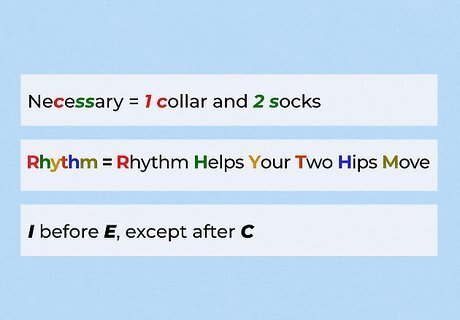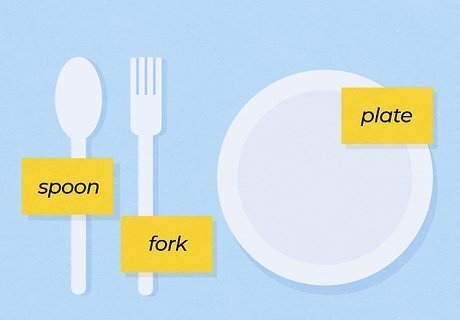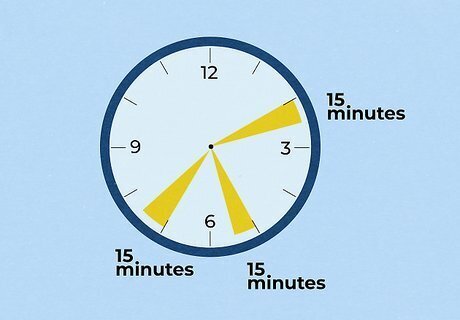
views
X
Research source
Memorizing the correct spelling of a word will take time and practice, but will help both your personal and professional communications.
- After getting the spelling basics down, use mnemonics to master challenging words and study words' origins to make spelling easier in the future.
- To help a child learn to spell, sound out words with them, teach pronunciation before spelling, and introduce 12-15 new words per week.
- To learn to spell in a new language, master the alphabet, learn the basics, practice writing and speaking with a native speaker.
Improving Your General Spelling Ability

Go back to the basics. Breaking down the word into syllables through exaggerated pronunciation, reviewing your phonics knowledge, studying spelling conventions and patterns, and keeping a word list for repetitious practice can greatly benefit adult learners. Keep your own spelling notebook on hand. Particularly if you are a visual learner, identifying new words to spell and practicing during free time will help you better remember how to spell the word. Consistent practice spelling your chosen words will etch the spelling into your memory. Review the “rules” of spelling to help you become a more proficient speller. For example, did you remember that the letter ‘c’ represents the sound /k/ when followed by an ‘a’, ‘o’, or ‘u’ (think cat, cot, cut), but represents the sound /s/ when followed by an ‘e’, ‘i’ or ‘y’ (think center, city, cycle)? Utilize online resources that are designed to improve spelling ability. Websites can be a helpful tool for practicing spelling in your spare time. There are also mobile apps that can help you drill spelling.

Try memory aids known as mnemonics. Mnemonics can be helpful to memorize the spelling of tricky words. While these memory aids are probably not effective for memorizing the spelling of a large number of words, they can be extremely helpful for memorizing a small number of complex words. You can use common mnemonics, or make up your own. Develop short phrases for complicated words. For example, “Necessary = 1 collar and 2 socks (to remember one ‘c’ and two ‘s’s).” Try spelling mnemonics that use a phrase. For example, “Rhythm = Rhythm Helps Your Two Hips Move.” Make up rhymes. For example, “‘I’ before ‘E’, except after ‘C’, or when sounded ‘A’, as in neighbor and weigh.” Compose nonsense stories. “In order to remember that ‘cemetery’ is spelled with three ‘e’s’, think of a lady shrieking “e-e-e!” as she walks past a cemetery.”

Explore the origin of words. Many commonly used words have roots in other languages, and understanding these roots can be helpful in both improving your vocabulary and memorizing the spelling of words. Because different languages abide by different spelling conventions, knowing the origin of a word can sometimes provide assistance in spelling it. Recognizing that long words often have a base which carries a specific meaning and remains constant despite the sound we hear can help with spelling. Learn some common Greek roots to help with spelling. For example, the Greek ‘ped’, meaning ‘foot’, is present in the words peddle, pedal, pedicure, and pedestrian, and the Greek ‘poli’, meaning ‘city’, can be found in metropolis, police, cosmopolitan, and political. Learn simple Latin roots to help with spelling. The Latin ‘ject’, meaning ‘to throw’, can be found in reject, eject, injection, and projectile, while the Latin ‘cred’, meaning ‘to believe’, can be found in incredible, credit, credible, incredulous, and credo.
Helping Children Memorize the Spelling of a Word

Create labels or artwork. This is a fun and interactive way to advance your child’s exposure to language, expand their vocabulary, and introduce spelling. Conversing while engaging with these projects will increase language capacity, which is the foundation of good spelling. Good spellers are usually also good readers and good speakers. Speak out loud. Spelling the words out loud as you write will introduce your child to verbal spelling. Make labeling a family activity. Encourage decoration of labels, or repetition of letters as you spell out the objects. Have your child trace words. Hold your child on your lap (or next to you) and place your hand over his, helping him to print a word while saying the word out loud and spelling the letters as you go. Try fingerpainting. This is a fun and involved way to learn letters and words. Fun introductions to spelling are the first step to learning how to successfully memorize the spelling of a word.

Teach children to spell by sounding out words. In addition to seeing words, which develops “visual memory,” children also need to enhance their “spelling memory”, or memory for letter sequences. This memory is enhanced by a child’s recognition of various phonemes, or speech sounds, used to construct words. Begin spelling with short words that are easy to sound out (think ‘cap’, ‘bat’, and ‘sit’ instead of ‘cape’, ‘bait’, or ‘sight’0. Use words in which the letter sounds correspond to their most common sounds (think “gram” instead of “gem”). Start by pronouncing and spelling these words and have your child repeat after you, and progress to asking your child to spell these words on his own. Introduce words in a logical pattern, beginning with words that adhere to the most basic and frequently encountered conventions. This will help your child see spelling conventions in words and learn to generalize from these words to others.

Assist with correct pronunciation before spelling. In order to learn the conventions of spelling and apply these conventions to other words, it is essential for your child to learn the correct pronunciation of his spelling words. Alternate between pronunciation and spelling. For example: “House. H-O-U-S-E. House.” Exaggerate pronunciation to teach the correlation between pronunciation and spelling. Encouraging children to remember to “pronounce it for spelling” can help them spell the word correctly in the future. Point out that not all words are spelled as they are pronounced. Words like “stranger”, “bomb”, and “should” can be confusing.

Practice, practice, practice. Be supportive of attempts at spelling. Learning how to spell and memorizing the spelling of a word will take practice. It is important to build your child’s confidence in spelling and avoid feelings of frustration or anger in association with spelling. Practice spelling in short bursts. Require fifteen minutes of spelling review after school, fifteen minutes after soccer practice, and fifteen minutes after supper. Shorter and more frequent periods of practice are often more effective than one long review session. Introduce 12-15 new words each week from second grade (age 8-9) on. Choose these words from reading material that your child may encounter in other classes, or pick groups of words that exhibit similar spelling conventions. Review old words as you introduce new words. Repetition is key in learning how to spell.
Learning to Spell Words in a Foreign Language

Learn the alphabet and the spelling conventions. Various languages sound different and look different as well. Just as you learned the ABC’s as a child, learning the alphabet of your intended language is the first place to start. You may encounter a few characters you’ve never seen before, or the language may look totally different to what you know. Identify characters that you do not have in your native language. For example, English speakers will recognize the letter ‘n’, while Spanish speakers need to know both ‘n’ and ‘ñ’, and French speakers will have to know ‘ç’ in addition to ‘c’. Understand the function of these characters in a word and how they are pronounced. Directly learning the sounds of the language and the letters those sound sequences represent will facilitate spelling.

Go back to the basics again. Just as a child learns to spell in his native language, you will need to start at the beginning. Breaking down words into syllables through exaggerated pronunciation and exploring patterns of pronunciation and spelling will help you learn to spell in any language. Review spelling patterns and the correlation between pronunciation and spelling. Break words down and identify any root words, if possible. Identify and pay specific attention to non-phonetic words. Understanding the spelling patterns and conventions of the language will help you identify these words. Use mnemonic devices or repetition to memorize both these patterns and the words to which they patterns apply. Be patient. Learning how to memorize the spelling of a word in your native language took time and effort. This will too.

Write it out, speak it aloud, and practice. It is best if you can have your written or spoken spelling checked by a native speaker. A native speaker will have a more keen sense of how to convey the conventions of his or her language and will be able to more effectively identify patterns of mistakes that you may be making in your spelling. Speak with a native speaker to ensure that you are pronouncing words correctly. Read in the language you wish to learn, and identify complex words for spelling practice. Practice spelling words by writing them in a notebook and testing yourself. Have a friend (and if possible, a native speaker) give you a spelling test out loud. This will help you better associate pronunciation and spelling.

















Comments
0 comment